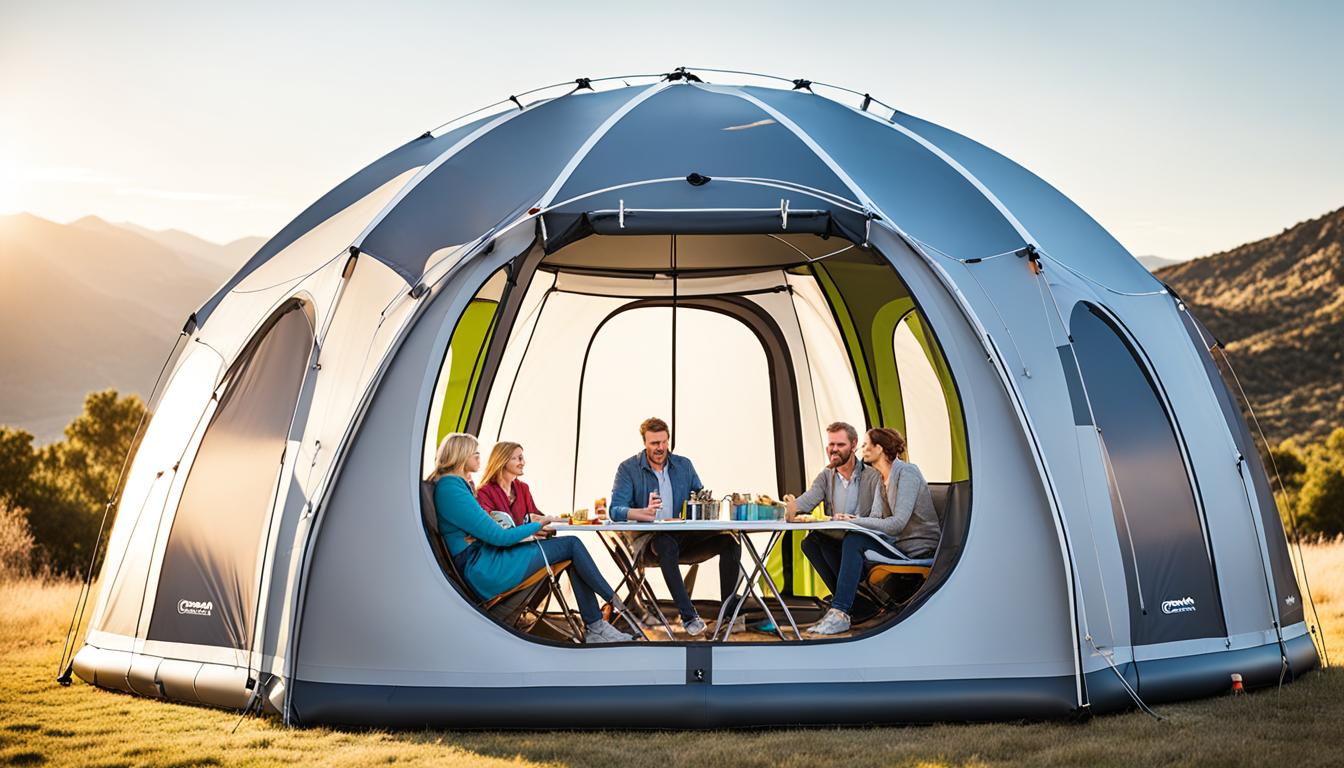Inflatable tents have become a popular choice for campers, adventurers, and outdoor enthusiasts worldwide. These modern marvels offer quick setup, lightweight portability, and durability, making them an essential piece of gear for those who love the great outdoors. But inflatable tents weren’t always as advanced as they are today. The journey of inflatable tents from rudimentary military designs to sophisticated camping gear is a fascinating story of technological innovation and adaptation. This article will explore the evolution of inflatable tents, their benefits, and how inflatable technology has also made its mark in the automotive industry with inflatable garages.
Early Beginnings: The Birth of Inflatable Structures
The concept of inflatable structures dates back to the mid-20th century. Initially, these structures were used in the military and aerospace industries due to their lightweight, portable nature. The earliest inflatable tents were rudimentary, designed to meet specific needs in remote or harsh environments where traditional materials and construction methods were impractical.
During World War II, inflatable technology saw its first significant application when the military used inflatable decoys to mislead enemy forces. These decoys mimicked tanks, artillery, and aircraft, providing a strategic advantage on the battlefield. While these early inflatables were not intended for human habitation, they demonstrated the potential of inflatable structures for lightweight, portable applications.
The Pioneering Days: Introduction of Air-Supported Tents
The real innovation in inflatable tents began in the 1950s when the Pneumatic Tent Company pioneered the use of air-supported structures. Instead of relying on traditional poles, these tents used inflatable beams—commonly known as air beams—to support the structure. This innovation drastically reduced the weight and complexity of tents, making them more accessible to the average camper.
Air beams offered several advantages over traditional poles. They were lighter, easier to transport, and quicker to set up. Additionally, air beams were more flexible, reducing the risk of breakage during storms or rough handling. This breakthrough marked the beginning of a new era in tent design, paving the way for the development of modern inflatable tents.
The 1970s: Advancements in Materials and Design
The 1970s brought significant advancements in the materials used to manufacture inflatable tents. The introduction of synthetic fabrics like ripstop nylon and polyester revolutionized the industry. These materials were lighter, stronger, and more resistant to tears and punctures than traditional canvas, making them ideal for inflatable tents.
Ripstop nylon, in particular, became a popular choice due to its durability and lightweight properties. This material is woven with a reinforcing technique that makes it resistant to ripping and tearing, a critical feature for outdoor gear subjected to harsh conditions. The combination of air-beam technology and high-strength fabrics allowed inflatable tents to become more reliable, durable, and weather-resistant, making them a viable option for serious campers and outdoor adventurers.
During this period, the design of inflatable tents also evolved. Manufacturers began experimenting with different shapes and configurations to improve stability, ventilation, and interior space. Dome-shaped tents became popular for their ability to withstand strong winds, while tunnel tents offered more interior space and better wind resistance. These innovations set the stage for the modern inflatable tents we see today.
Modern Innovations: The Pinnacle of Inflatable Tent Design
Today’s inflatable tents are marvels of engineering, combining the latest materials and design innovations to create versatile, durable, and user-friendly shelters. Modern inflatable tents are designed to withstand extreme weather conditions, from heavy rain and strong winds to scorching heat and freezing temperatures. They are constructed from high-quality materials, such as ripstop nylon or polyester with waterproof coatings, ensuring they remain durable and reliable in all conditions.
One of the most significant advantages of modern inflatable tents is their ease of setup. Traditional tents can be cumbersome and time-consuming to pitch, often requiring multiple people and a considerable amount of time to assemble. In contrast, inflatable tents can be set up in just a few minutes using a manual or electric pump. This convenience has made inflatable tents increasingly popular among outdoor enthusiasts, particularly those who value time and simplicity.
Modern inflatable tents also offer a range of features designed to enhance comfort and usability. For example, many models include integrated ventilation systems to prevent condensation, multiple entry points for easy access, and spacious interiors that provide ample room for sleeping and storing gear. Some high-end models even feature built-in LED lighting, power outlets, and solar panels, making them ideal for extended camping trips or off-grid adventures.
The Benefits of Inflatable Tents
Inflatable tents offer several key benefits that make them an attractive option for campers and outdoor enthusiasts:
- Quick Setup: Inflatable tents can be set up in minutes, making them ideal for spontaneous trips or late arrivals at campsites.
- Lightweight and Portable: These tents are generally lighter than traditional tents, making them easier to carry and transport.
- Durability: High-quality materials and sturdy air beams provide excellent stability and weather resistance.
- Versatility: Available in various sizes and configurations, inflatable tents cater to different camping needs, from solo adventurers to large families.
- Comfort: Many inflatable tents offer spacious interiors, multiple entry points, and integrated ventilation systems, enhancing overall comfort.
Inflatable Garages: Revolutionising Vehicle Protection
The innovation of inflatable technology hasn’t been limited to outdoor gear. Inflatable garages, also known as car capsules or car bubbles, have become a popular solution for protecting vehicles from the elements. These inflatable structures offer a unique combination of convenience, portability, and comprehensive protection, making them an attractive option for car owners who want to preserve the condition of their vehicles.
What Are Inflatable Garages?
Inflatable garages are temporary, portable shelters designed to protect vehicles from environmental damage. They are typically made from heavy-duty PVC or other durable materials that can withstand harsh weather conditions, such as rain, snow, UV rays, and dust. The structure is supported by air beams, similar to inflatable tents, which provide stability and protection for the vehicle inside.
These inflatable garages are often used to protect luxury vehicles, classic cars, motorcycles, and other valuable assets that require extra care. The inflatable design allows them to be set up quickly and easily, making them ideal for temporary or seasonal use.
Key Features of Inflatable Garages
Inflatable garages are designed with several key features that make them effective and convenient for vehicle storage:
- Durable Materials: Inflatable garages are typically made from heavy-duty PVC, which is resistant to tears, punctures, and UV damage. This ensures that the structure can withstand various weather conditions and provide long-lasting protection.
- Airflow System: Many inflatable garages feature a continuous airflow system that prevents condensation from forming inside the structure. This system helps keep the vehicle dry and reduces the risk of rust, mold, and mildew.
- Quick Setup: Inflatable garages can be set up quickly using a manual or electric air pump. Some models can be fully inflated in less than five minutes, making them convenient for both permanent and temporary use.
- Portability: Inflatable garages are lightweight and portable, allowing them to be set up on almost any terrain. This flexibility makes them an ideal solution for car owners who need a temporary storage option or frequently move their vehicles.
Benefits of Inflatable Garages
Inflatable garages offer several advantages over traditional vehicle storage solutions:
- Comprehensive Protection: Inflatable garages provide a controlled environment that shields vehicles from environmental elements, such as rain, snow, UV rays, and dust. This protection helps preserve the vehicle’s paint, interior, and mechanical components.
- Ease of Use: The quick setup and takedown process make inflatable garages convenient for temporary or seasonal use. They can be easily deflated and stored when not in use, saving space and reducing maintenance.
- Cost-Effective: Compared to building a permanent garage, inflatable garages are a more affordable solution. They eliminate the need for construction permits and reduce upfront costs while providing similar levels of protection.
- Versatility: Inflatable garages can be used in a variety of settings, from residential driveways to remote locations. Their portability and ease of setup make them a versatile option for car enthusiasts and owners of valuable vehicles.
The Future of Inflatable Technology: What’s Next?
The evolution of inflatable tents and garages is a testament to the versatility and potential of inflatable technology. As materials and design techniques continue to improve, we can expect even more innovative applications in the future.
Sustainability: The Rise of Eco-Friendly Materials
As environmental concerns become increasingly important, the use of eco-friendly materials in the production of inflatable structures is likely to grow. Manufacturers may explore biodegradable or recyclable materials that offer the same durability and strength as traditional options. Additionally, sustainable manufacturing processes, such as reducing waste and conserving energy, may become standard practice in the industry.
Smart Features: Integrating Technology into Inflatables
The integration of smart technology into inflatable tents and garages could enhance their functionality and user experience. For example, inflatable tents with built-in solar panels could generate electricity for lighting or charging devices, while inflatable garages with temperature and humidity sensors could provide real-time data on the internal environment. These innovations would make inflatable structures more adaptable and convenient for a wider range of uses.
Expanded Applications: Beyond Camping and Vehicle Storage
Beyond camping gear and vehicle protection, inflatable technology has the potential to be applied to a variety of other industries and applications. For example, inflatable emergency shelters could provide quick, temporary housing for disaster victims, while inflatable medical tents could serve as portable field hospitals in remote or disaster-stricken areas. Additionally, inflatable furniture, such as chairs, sofas, and beds, could offer a lightweight, portable solution for temporary or outdoor use.
Embracing the Future of Inflatable Technology
The journey of inflatable tents and garages from basic, military-grade designs to modern, sophisticated products is a testament to human ingenuity and innovation. As the technology continues to evolve, the possibilities for inflatable structures are virtually limitless. The evolution of inflatable tents and garages showcases the incredible potential of inflatable technology. As materials and design techniques continue to improve, we can expect even more innovative applications in the future.
The Enduring Appeal of Inflatable Structures
From their humble beginnings to the advanced designs of today, inflatable tents and garages have proven their value in a variety of contexts. Whether you’re an outdoor enthusiast looking for a reliable tent or a car owner seeking a convenient storage solution, inflatable technology offers practical, innovative, and cost-effective options.
As the technology of inflatable structures continues to evolve, the possibilities for inflatable structures are virtually limitless. Their combination of portability, durability, and ease of use ensures that they will remain a popular choice for both recreational and practical applications for years to come.





